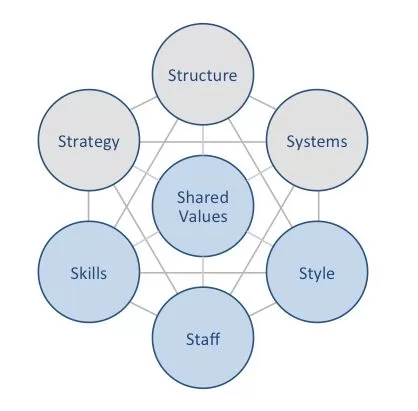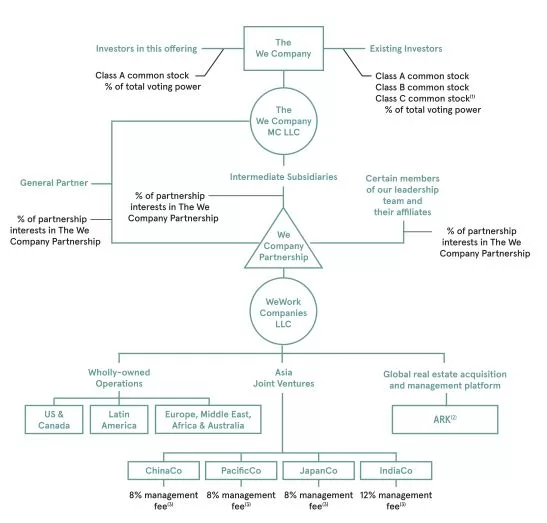Search results for: Ansoff Matrix

WeWork marketing communication mix comprises communication channels to communicate the marketing message to the target customer segment. These channels are print and media advertising, sales promotions, events and experiences, public relations and direct marketing. WeWork Print and Media Advertising The global flexible workspace provider uses print and media advertising extensively. The company uses TV, radio, magazines, newspapers, billboards and posters to convey their markeing message to potential customers. Specifically, WeWork print and media advertisements aim to encourage entrepreneurs and business owners to re-image their workspace to be a flexible and creatively designed to make the work process a highly rewarding experience. Recently, WeWork India started a brand campaign, ‘Great Inspires Great’, launching a series of three product films featuring their core products ‘On-demand’, ‘Managed Office’, and ‘Space as a Service’[1]. WeWork Sales Promotions Sales promotions can be defined as a marketing strategy where a company uses short-term campaigns to spark interest and create demand for a product, service or other offers. We work is not famous for using various forms of sales promotions techniques. The global flexible workspace provider occasionally offers free gifts as a sales promotion strategy. For example, in 2020 WeWork offered one month trial gift for new All Access subscription members. The global flexible workspace provider does not use seasonal sales promotions, discount vouchers, money off coupons, competitions, discount vouchers, loyalty program sales promotions methods. This is due to nature of products and services the company offers. WeWork Inc. Report contains a full analysis of WeWork marketing communication mix and WeWork marketing strategy in general. The report illustrates the application of the major analytical strategic frameworks in business studies such as SWOT, PESTEL, Porter’s Five Forces, Value Chain analysis, Ansoff Matrix and McKinsey 7S Model on WeWork. Moreover, the report contains analyses of WeWork leadership,…

WeWork marketing mix (WeWork 7Ps of marketing) comprises elements of the marketing mix that consists of product, place, price, promotion, process, people and physical evidence. Product Element in WeWork Marketing Mix (WeWork 7Ps of Marketing) WeWork offers the following three products and services: Space as a service. Coworking space for small to medium sized businesses and flexible space solutions for enterprise companies. WeWork access. Workspaces around the world by the hour, day, or month through monthly subscription All Access product or pay-as-you-go On Demand product. Services within access category are similar to a gym membership model in a way that membership sales are not limited by the desk capacity within premises. WeWork Workplace. Workspace management software solution. It is software for landlords for online booking of desks, offices, collaboration hubs, and meeting rooms, in addition to providing meaningful utilization analytics, and helping to optimize space across assets. Place Element in WeWork Marketing Mix (WeWork 7Ps of Marketing) The co-working giant has a network of 756 locations in 38 countries, including 277 locations in the US as of December 2021. Customers can find information regarding the address of each location on company’s website and purchase WeWork products and services in any of these locations. Furthermore, customers can book flexible workspace using WeWork app at a time and place that is convenient to them. Price Element in WeWork Marketing Mix (WeWork 7Ps of Marketing) WeWork pricing strategy includes the following elements: Flexible pricing. The co-working giant applies a wide range of pricing options such as daily pay-as-you-go, as well as, monthly and yearly membership fees. Global flexible workspace provider can also offer custom payment plan for its large enterprise customers. Geographical pricing. As mentioned the workspace provider operates in 38 countries and prices vary in each country to…

WeWork McKinsey 7S model highlights the ways in which seven elements of businesses can be aligned to increase effectiveness. According to this model strategy, structure and systems represent hard elements, whereas shared values, skills, style and staff are soft elements. McKinsey 7S model stresses there are strong links between elements in a way that a change in one element causes changes in others. As it is illustrated in figure below, shared values are placed at the core of WeWork McKinsey 7S model, because shared values guide employee behaviour with implications on their performance. Hard Elements in WeWork McKinsey 7S Model Strategy. WeWork pursues simplification business strategy. Specifically, co-working giant simplifies the notion of flexible workspace and makes it practical for businesses of all sizes through offering space as service. Furthermore, the company is on the path of digitalizing real estate business on the global scale. Structure. Under the leadership of co-founder and former CEO Adam Neumann WeWork organizational structure was chaotic and ineffective. The current CEO Sandeep Mathrani restructured the company to a great extend to make it more simple and transparent. Currently, global flexible workspace provider has an hierarchical organizational structure. Systems. The workspace provider relies on a wide range of systems for its daily operations. These include employee recruitment and selection, team development and orientation, transaction processing systems. Furthermore, customer relationship management, business intelligence, knowledge management systems are also important for WeWork. WeWork Inc. Report contains a full analysis of WeWork McKinsey 7S Model. The report illustrates the application of the major analytical strategic frameworks in business studies such as SWOT, PESTEL, Porter’s Five Forces, Ansoff Matrix and Value Chain analysis on WeWork. Moreover, the report contains analyses of WeWork leadership, business strategy organizational structure and organizational culture. The report also comprises discussions of WeWork marketing strategy, ecosystem…

WeWork segmentation, targeting and positioning is an important tool for the global flexible workspace provider to develop right products and services for right customers. Segmentation involves dividing customers into different groups according to their common needs and common characteristics. Targeting implies selecting specific groups among the population to sell products and services to. Positioning refers to developing elements of the marketing mix that best resonates with the needs and wants of the target customer segment. WeWork uses the following types of positioning: 1. Functional positioning. Functional positioning refers to positioning of products and services that are aimed at solving specific problems customers are facing. Businesses needed flexible workspace solutions without commitment of lengthy and expensive lease. Adam Neumann and Miguel McKelvey saw commercial opportunity in this problem and established WeWork with functional positioning in 2010. 2. Multi-segment positioning. The co-working giant offers services to more than one customer segment in terms of their workspace needs. For example, ‘Space as a service’ category is developed for small and medium sized businesses and enterprise companies. ‘WeWork Access’ category, on the other hand, aims to attract different customer segment, namely sole entrepreneurs at the early stages of their journey in business. The following table illustrates WeWork segmentation, targeting and positioning: Type of segmentation Segmentation criteria WeWork target customer segment Geographic Region 38 countries worldwide Density Mainly urban areas Demographic Age 18-65 Gender Males & Females Life-cycle stage Bachelor Stage: young, single people not living at home Newly Married Couples: young, no children Full Nest I: youngest child under six Full Nest II: youngest child six or over Full Nest III: older married couples with dependent children Empty Nest I: older married couples, no children living with them Occupation Self-employed, professionals, senior manager, executives, business owners Behavioral Degree of loyalty ‘Hard core loyals’ ‘Soft core loyals’ ‘Switchers’ Benefits…

Co-founder and former CEO Adam Neumann had a compelling vision for WeWork ecosystem. It has been noted that “Neumann has even expressed a desire to one day have entire WeWork communities, where everything from your apartment to the school your children attend is brought to you by WeWork”[1] The main components of the ecosystem as envisioned by Neumann include the following: WeGrow private school. The curriculum featuring ‘conscious entrepreneurship’, the school was actually the brand child of Adam Neumann’s wife Rebecah. WeGrow school closed only a year later after enrolling around 100 children in 2018 for the tuition cost of up to USD 42k.[2] WeMrkt physical store. Opened in 2010, WeMrkt physical store offered products such as Icelandic yogurt and chickpea snacks sourced from WeWork member companies. Powered by We. A range of services that transform data to design. These services include helping clients find the right physical space, construction, custom office decor, software to manage building operations, back-end data on the efficiency of the office space, and even WeWork employees physically on-site to help with community programs.[3] HQ by WeWork. Private and personalized headquarters for medium sized businesses. WeWork Labs. An initiative to assist early-stage start-ups with growth through education, mentorship, and an agile workspace. The program was shut down in 2022. Rise by We. A premium fitness concept presented as an ultimate wellness club. WeLive. Furnished, community-oriented shared living apartment suite rentals, offering amenities in select US metropolitan areas. Almost all of the initiatives listed above that were planned as important components as WeWork ecosystem have failed. However, it is important to note that in most cases the failure may not be an indication of flaw of respective ideas. Rather, the failure of these initiatives can be attributed to the following main two reasons: 1. Poor leadership. It is now…

WeWork marketing strategy is based on the following principles: 1. Effective use of social media marketing. The global flexible workspace provider efficiently uses social media marketing through viral marketing, localized Facebook ads appealing to the needs and wants of the local customer segment. Furthermore, there are many YouTube videos with positive customer testimonials for using WeWork co-working spaces with positive implications on the brand image. 2. Celebrity endorsement. Although the leadership style of the co-founder and former CEO Adam Neumann had proved to be devastating for the company, he was able to engage in celebrity endorsement in cost-effective manner. Celebrities such as Drake, Ashton Kutcher and Hugh Jackman were spotted in WeWork headquarters with positive implications to the brand image. The co-working giant continued with celebrity endorsement even after the departure of Neumann. 3. Focus on the product and place. Within the framework of 7Ps of marketing WeWork focuses on product and place elements of the marketing mix to a greater extend compared to other elements. The global flexible workspace provider offers workspace as a service – creatively designed, furnished, flexible and without long-term commitments. This is the unique selling proposition for WeWork. The co-working giant has a network of 756 locations worldwide, including 277 locations in the US as of December 2021. 4. Effective market segmentation and positioning. The co-working giant uses functional and multi-segment positioning techniques and targets customers mainly in urban areas in 38 countries worldwide. In terms of occupational segmentation criteria WeWork targets self-employed individuals, professionals, senior managers, executives and business owners. 5. Integrated use of marketing communication mix. The co-working and office space operator uses several marketing communication channels such as print and media advertising, sales promotions, events and experiences and public relations in integrated way to communicate marketing message to the target customer segment.…

WeWork PESTEL analysis is a strategic analytical tool and the acronym stands for political, economic, social, technological, environmental and legal factors affecting the global flexible workspace provider. Political Factors in WeWork PESTEL Analysis Political factors that can affect workspace providers such as WeWork are multiple and include government stability, tax policies, lobbying and level of bureaucracy. Co-working providers are also affected by corruption, freedom of press, activities of trade unions and other factors. Government stability Government stability plays an important role on the long-term growth prospects of WeWork. The global flexible workspace provider operates 756 locations in 38 countries[1]. Changes in government policies may impact WeWork’s ability to secure office space, enter in lease agreements and manage its workforce. Furthermore, government instability or war such us the one currently going on in Ukraine can result in the loss of WeWork properties with direct implications on the bottom line. Tax Policies WeWork is subject to tax policies in all 38 countries it operates. The co-working giant is directly affected by corporate taxes. The higher the corporate taxes, the higher is the cost of doing business in any particular region. Moreover, favourable treatment of leases in some countries increases the company’s profitability, considering that the workspace provider leases the majority of its locations. Despite its huge size, in the past WeWork had benefited from tax breaks intended for small businesses. Specifically, by 2019 the company had received about GBP 2 million tax refund on property taxes it had paid in UK.[2] Lobbying Lobbying can affect the performance and growth prospects of the global flexible workspace provider. It is an attempt by individuals or organizations to influence government decisions. Potentially lobbying can benefit co-working and flexible working sector through tax befits for leasing arrangements and providing other benefits…

SWOT is an acronym for strengths, weaknesses, opportunities and threats related to organizations. The following table illustrates WeWork SWOT analysis: Strengths 1. Strong liquidity 2. International presence 3. Experience 4. Brand recognition Weaknesses 1. Business has not achieved profitability 2. High level of indebtedness 3. Damaged company image 4. Business model easy to replicate Opportunities 1. Entering into strategic collaborations 2. Strengthening WeWork ecosystem 3. Finding new sources of competitive advantage 4. Increasing marketing efficiency Threats 1. Inability of Sandeep Mathrani to turn around the business 2. Members seeking payment concessions or deferrals or cancellations 3. Emergence of new competitors with innovative business models 4. Changes in customer attitudes towards shared workspace WeWork SWOT Analysis Strengths in WeWork SWOT Analysis 1. WeWork has a strong liquidity. As of December 31, 2021, the company had access to USD2.0 billion of liquidity in the form of cash and commitments from its lenders. Strong liquidity offers a range of benefits for the workspace provider such as ability to meet short-term debts and dealing with unforeseen circumstances. 2. The global flexible workspace provider operates a network of 756 locations in 38 countries as of December 2021. Global presence offers a range of advantages for the workspace provider. These include economies of scale, access to local talent and opportunity to increase revenues. 3. WeWork had to deal with a range of serious issues such as ineffective management, severely flawed corporate culture and starting many initiatives at the same time. These setbacks damaged the brand image to a considerable extent. At the same time, it can be argued that the process of having to go through these problems have been a valuable experience for employees at all levels. Specifically, thanks to these issues WeWork employees at all levels are more mature now and they…

A documentary released by Hulu on April 1st 2021 provides an insight on WeWork organizational culture and its serious shortcomings under the leadership of co-founder and former CEO Adam Neumann. At that time corporate culture at WeWork was notorious for ‘frat-boy’ culture, sexual abuse, motivational mantras and free beer. The co-working giant organized annual employee retreat on a remote island. The company engaged in tracking employees at mandatory, alcohol-fuelled company events and an onboarding process that made all new employees shout WeWork until red in the face. New CEO, real estate veteran Sandeep Mathrani who took helm in February 2020 brought maturity and discipline into the company with direct implications on organizational culture of WeWork. Dubbed as ‘anti-Adam Neumann’ the new CEO was quick to put a stop at extravagant company events and cut costs in many other ways. Under the new leadership the global flexible workspace provider has committed to zero tolerance to discrimination and abuse at workplace in any form and these changes are more than welcomed by stakeholders. Mr. Mathrani is committed to change the important components of WeWork organizational culture in the following ways: Values. Mathrani specified the following values to be central for the co-working and office space operator: Do the right thing Strive to be better, together Be entrepreneurial Give gratitude Be human, be kind Attitudes. New CEO expects mature and more responsible attitude towards the work from employees at all levels. Norms and expectations. Employees are expected to work hard, deliver results and be considerate towards their co-workers. Discrimination and abuse is no longer tolerated at the co-working giant. Rituals, symbols and routines. Extravagant rituals such as shouting WeWork at company gatherings, ordering coffee from WeWork’s in-house barista and many others popular under Adam Neumann were put to stop permanently. WeWork…

Under the leadership of co-founder and former CEO Adam Neumann WeWork organizational structure was complex. Figure 1 below is a ‘simplified’ version of WeWork organizational structure the company submitted for IPO Prospectus on August 2019. The structure fails to clearly illustrate the organization of the business from the viewpoint of who reports to whom. It also fails to clearly indicate the flow of information, an essential component of a good organizational structure. Figure 1 We Work organizational structure under Adam Neumann If this is a ‘simplified’ version, it would be safe to assume that the original version would be much more difficult to comprehend. Ineffective organizational structure is one of the main reasons why global flexible workspace provider faced near bankruptcy in 2019. After the departure of Adam Neumann, the new CEO Sandeep Mathrani restructured the business simplifying the organizational structure to a great extend with a clear pattern for information flow. Figure 2 Current pattern of WeWork organizational structure Organizational structure of WeWork can be classified as hierarchical. Such a structure offers advantages to the co-working giant such as creating a landscape for Sandeep Mathrani to turn around the business to make it suitable for long-term. Hierarchical structure offers clear delegation of authority and encourages specialization among employees at all levels. On the negative side, hierarchy can cause rivalries between various departments. It can also slow down the implementation of proposed changes through loss or misinterpretation of information along the hierarchy. The current organizational structure of WeWork may change in the foreseeable future because the structural changes by Mathrani are far from complete. Mathrani has predicted flexi-working revolution at a global scale[1] and he is striving WeWork to lead such a revolution. WeWork Inc. Report contains the above analysis of WeWork organizational structure. The report illustrates the…
